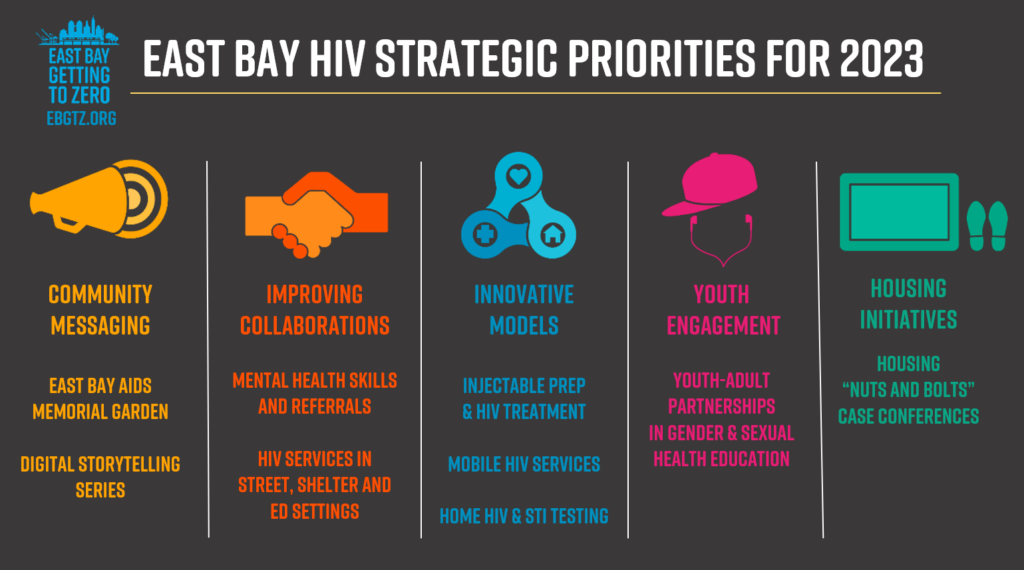HIV updates
Find the latest East Bay HIV updates on this page, including practice-changing studies and developments.


| Vision | Engage youth advisory boards, LGBTQ youth teams, youth outreach workers, community-based youth organizations, providers and schools on community messaging and outreach, low-barrier PrEP and sexual health care, and build youth leadership pipeline. |
| Top priorities for 2023 | 1. Low-barrier access to care: best practices shared and piloted through the youth clinical provider group, and messaging developed by the youth group. 2. Sex positive education through Youth-Adult Partnerships: engage parents and trusted adults in listening sessions about gender identity, sex positivity, reproductive/sexual health care alongside teams at youth-serving organizations to destigmatize sexual health services and support participation in comprehensive sexual health programs. |
| Accomplishments in 2021 and 2022 | – First graduates of the Youth Internship Program: two youth interns were hired in 2021 to develop and distribute education via youth-focused social media. In Dec 2022, Ramirez Brown and Gabriel Jimenez completed the program and joined EBGTZ staff as Youth Engagement & Communications Specialists. – Youth-led community messaging: completion of the Love & Rage Mural. In partnership with RYSE Youth Center, the first EBGTZ mural featuring a collaboration between a local artist and youth was debuted to the public. – Youth-led community outreach events: EBGTZ held a youth-focused HIV testing event in June 2021 that featured rapid testing and PrEP information. – Structural improvements to minor-consent Medi-Cal: In 2021, a policy change was made to allow minor-consent Medi-Cal electronic/remote re-certifications, though they are still monthly. Family PACT policy change was made to include PrEP services and STI care for all genders and sexual orientations, and no longer requires contraception services. |
| Equity Activities | – Train all youth-serving providers to refer patients to youth-specialized services with a focus on vulnerable youth (unstable housing, sex trafficking, YMSM/QTPOC). – Integrate the network of youth leaders and youth-serving providers into the larger EBGTZ community messaging efforts. Community messaging is discussed at each youth working group meeting, integrating youth voices into broader community messaging campaigns, including diverse, sex positive and creative messages. – Support youth leadership capacity-building and the HIV/STD care/prevention pipeline including youth-to-youth, train-the-trainer education, and compensate youth appropriately for their work. |
| Activities planned for 2023-2025 | Low-barrier access to care and regional youth network: – Youth-serving providers in the network continue to: share best practices and build capacity to provide low-barrier HIV prevention and testing; strengthen PEP-to-PrEP and PrEP services in emergency departments, juvenile justice centers, sexual assault support programs; Increase the number of clinics with same-day PrEP and PrEP starter packs; Develop sustainability plans, utilizing grants to increase service capacity and integrating services into existing longer-term processes. – Youth leaders from youth advisory boards, LGBTQ youth teams and youth outreach workers aim to: Identify groups of youth who need additional support; Identify sex-positive language for HIV prevention. Sex positive youth community messaging: – Integrate the network of youth leaders and youth-serving providers into the larger EBGTZ community messaging efforts. – Develop a collaborative youth outreach event for HIV testing and sex-positive education through events such as National Youth HIV Testing Day or National HIV Testing Day. – Develop messaging using a sex positive approach to address stigma and provide resources and skill-building for trusted adults supporting youth – Develop a youth leadership pipeline program |
| Structural change | Process changes for youth-serving providers to integrate universal, opt-out HIV testing, PEP and PrEP services in a wide variety of youth-centered settings. |
| Metrics, evaluation and improvements | Short-term (annually): – Track number of youth-serving providers and youth leaders in the network. – Track the number of sites providing PEP and PrEP services. – Track PEP and PrEP prescriptions by age and in youth-focused settings. – Collect feedback from youth leadership on needs/gaps to improve services. — Track and share demographic data on HIV diagnoses among young people, including racial/ethnic, gender/sexual orientation, geographical location, etc. Medium-term (2-5 years): – Develop and implement new interventions to address needs and gaps and increase equitable access to PEP and PrEP for youth. – Increase the number of youth leaders and providers in the network. – Increase the number of providers and sites providing same-day PEP and PrEP. – Increase HIV testing, PrEP uptake and HIV treatment rates among youth 13-24. Long-term: Decrease new HIV diagnosis rates among youth 13-24. |
Find the latest East Bay HIV updates on this page, including practice-changing studies and developments.
Updates on the East Bay HIV strategic plan are posted on this webpage. This is a community-driven “living” East Bay HIV strategic plan that is flexible and responsive to local needs, addresses structural inequities, and is used to make systemic change to achieve our vision of an East Bay with zero HIV stigma, zero health disparities, and zero new HIV transmissions.
On December 17, 2019, we were honored to receive an award from the Alameda County Board of Supervisors congratulating and commending “East Bay Getting to Zero for launching an important … Continued